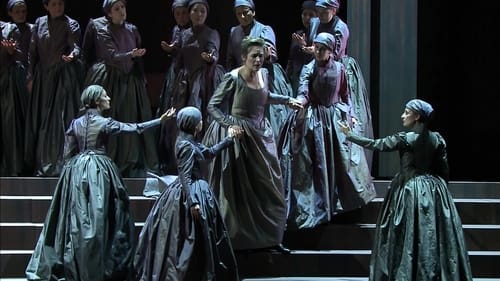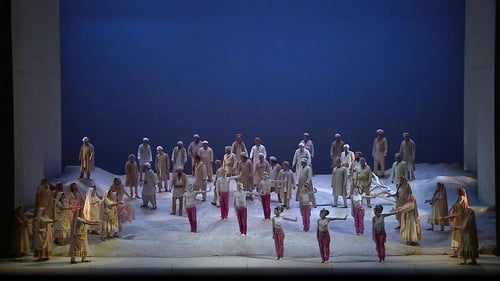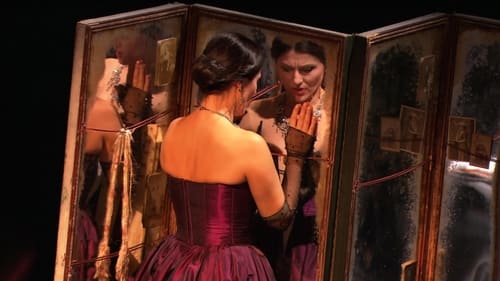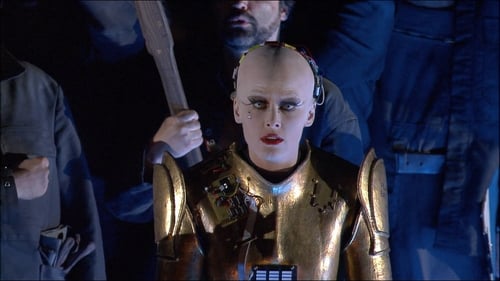
FERRANDO
Passions run high as Manrico and the Count di Luna compete for the affections of Leonora. Little do they know, Manrico’s mother Azucena has been keeping a terrible secret for decades. Soon a curse from the past will rise up from the ashes with devastating implications for them all. Starring Rachel Willis-Sørensen, Yusif Eyvazov, Gregory Kunde, Ludovic Tézier and Jamie Barton, Adele Thomas’s energetic staging sets Verdi’s tale in a Hieronymus Bosch-inspired universe of medieval superstition. On the podium, Antonio Pappano conducts Verdi’s dramatic score, featuring the famous Anvil chorus.

“Manon is like any person who, strolling down the street one day, glances up at a second-story window and catches a glimpse of a different life,” explains Vincent Huguet about his staging of Massenet’s Manon, “a life that she suddenly desires ardently … and will do anything to have.” In his update of Prévost’s famous novel, Huguet demonstrates, with empathy and acuity, that Manon’s tale could really be anyone’s.

Leporello

As Aragon descends into unrest, a count jealously fights for a noble lady's heart. But she has already given it to a passionate troubadour whose mother holds a terrible secret. This Verdi masterpiece overflows with dramatic tension and musical geniality, resulting in a story that increases in intensity throughout. Maria Agresta plays the unfortunate Leonora alongside Ludovic Tézier and Francesco Meli as her rival admirers in this new production at the Teatro Real.

Love can be questionable, especially when it involves forgery and attempted murder. David Alden directs and Daniel Oren conducts.

Colline
No one better described the half-starved, struggling artists than Murger in his Scènes de la Vie de Bohème: artists ready to burn a manuscript to try to keep warm yet,in an era of triumphant bourgeois materialism, dreaming of another existence. Taking up these scenes of Bohemian life, Puccini offers us a heart-breaking love story and some of the most beautiful music in the history of opera in the story of the poet Rodolfo and fragile Mimi. The staging of this new production has been entrusted to Claus Guth who sets the drama in a future devoid of hope in which love and art become the sole means of transcendence.

Lindorf, Coppélius, Dapertutto, Miracle
This adaptation of three tales by E.T.A. Hoffmann, with a sprinkling of Goethe’s Faust, portrays the German poet as both narrator and hero recounting his love affairs with Olympia, Antonia and Giuletta. Robert Carsen’s spectacular production highlights the melancholy genius of a man marked by life, with a coherence and dramatic sense remarkable for a work that leaves numerous questions unanswered. Under the baton of Philippe Jordan, Stéphanie d’Oustrac, Ermonela Jaho, Kate Aldrich, Yann Beuron and Ramón Vargas and Stefano Secco in the main role, interpret the legendary airs of this work whose brilliant mystery will continue to dazzle opera houses for countless years to come.

Escamillo
With a devilish sway of the hips and a hint of Andalusian flair, Carmen, the beautiful cigar-maker sets her sights on a soldier: Don José. Fate will do the rest. Composed to a libretto by Meilhac and Halévy based on Prosper Mérimée’s novella, the opera exploded the boundaries between tragedy and comedy with a modernity that caused a scandal at the time. Can we kill the one we love with love? The fiery beauty of Bizet’s music, where one unforgettable aria follows another, has worked year in, year out to make it the world’s most performed opera.

Lindorf / Coppélius / Dapertutto / Miracle

Ferrando
Alex Ollé, one of the famous La Fura dels Baus, recreates the conflict and places principal protagonists in clear, transforming set with supporting lighting – facing all primal emotions directly, with no place to hide. The set design (smart and impressive solution of scenography by Alfons Flores) encased in mirrors and accented with silently moving columns, creating cloister, battlefield, cemetery or castle with minimalistic hints (impressive lighting design by Urs Schönebaum), gives us the opportunity to keep full attention on the vocal performance of main characters.

This production of Lucia was the work of Stefano Mazzonis di Pralafera who is the General Director of the company. In his detailed program note he wrote about how he had clearly thought about the setting and the relationship between the libretto and the original novel. This was a very classic staging – one where the gentlemen wore tartan kilts and the ladies long, flowing dresses. There was a lot of standing and delivering and a fair bit of falling to the floor with Enrico in particular seeming to have a thing for pushing other characters to the floor.

Jacopo Loredano
Part of Tutto Verdi series - I due Foscari (2009) Parma

The King
The grand scale and magnificent acoustics of the Roman arena in Verona are ideally suited to the pageantry of Verdi's Egyptian opera, presented here in a staging that is true to the original 1913 production, framed by obelisks and sphinxes and filled with chorus and dancers. Chinese soprano Hui He has won international acclaim for her portrayal of the eponymous slave girl whose forbidden love for the war hero Radamés (Marco Berti, the experienced Verdi tenor) brings death to them both.

Monje
Teatro Regio’s 2013 revival of their highly successful 2006 production of Verdi’s Don Carlo celebrates the 40th anniversary of the theatre’s reopening in 1973. With traditional staging and lavish costume design, the production garnered high acclaim in the national and international press, with GB Opera commending the ‘sumptuous’ setting and French online music magazine ResMusica praising director Hugo de Ana’s decision to revive the show ‘in all its splendour’. Shown here in the four-act version, Don Carlo is the fascinating tale of father-son power struggles, adultery and love that borders on incest. The cast – under the powerful baton of Gianandrea Noseda – is headed by renowned Mexican tenor Ramón Vargas, and also features Ludovic Tézier, who has been hailed as ‘one of the best Verdian singers of our time’

Nourabad
The Pearl Fishers from 1863 concerns an opera in three acts. It's a work about friendship, love, faithfulness and betrayal. The story takes place in Sri Lanka. The pearl fishers Nadir and Zurga are both in love with the girl Leïla. In order to maintain their friendship, the swear not to court the girl. They promise never let go of their friendship end over the love for th a girl. Then they lose sight of the girl. Years later, Leïla returns as a priestess back to the fishermen's village. Nadir recognizes her and courts her. The two are caught and the sentence is the pillar. Zurga, now the fisherman's captain, avoids this and lets them escape. The angry villagers grabbed him and threw him on the pile of fire that was intended for the two lovers.

Il Re

Jacopo Loredano
I due Foscari was Verdi's sixth opera and based on Lord Byron's play The Two Foscari. Rich in intrigue, the plot tells of the final days of the famous Venetian doge, Francesco Foscari, and his illegal overthrow in 1457.

Pirro
I Lombardi alla prima crociata (The Lombards on the First Crusade) was Verdi’s fourth opera and received its first performance at La Scala, Milan, in February 1843. The grandiloquent subject matter is fleshed-out with broad-brushed musical and dramatic effects and lavish choral scenes created a correspondingly impressive impact. A great success in Milan, it spread to the rest of Europe within a matter of only a few years.

Monterone
Live recording at Parma Verdi Festival 6 October, 2008. Massimo Zanetti conducting Orchestra e Coro del Teatro Regio di Parma. Stage director Stefano Vizioli.

Dottore Grenvil
Part of Tutto Verdi series - La Traviata (2007) Parma. 'La traviata' ('The Fallen Woman') is an opera in three acts by Giuseppe Verdi set to an Italian libretto by Francesco Maria Piave. It is based on 'La dame aux Camélias' (1852), a play adapted from the novel by Alexandre Dumas, fils. The opera was originally titled 'Violetta', after the main character. It was first performed on 6 March 1853 at the La Fenice opera house in Venice. Piave and Verdi wanted to follow Dumas in giving the opera a contemporary setting, but the authorities at La Fenice insisted that it be set in the past, "c. 1700". It was not until the 1880s that the composer and librettist's original wishes were carried out and "realistic" productions were staged.

Bernardino
Live performance from Salzburg Festival Opera, August 2007.
The story tells of Cellini's love for Teresa, daughter of the Papal Treasurer Balducci. His rival, the Papal Sculptor Fieramosca, overhears Cellini plotting to run away with Teresa during the carnival.















